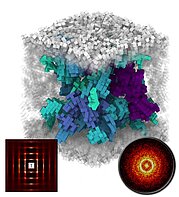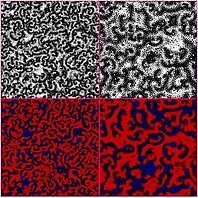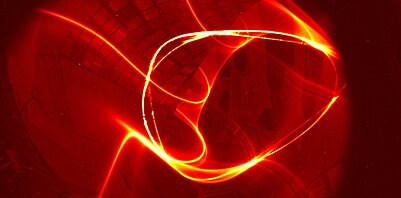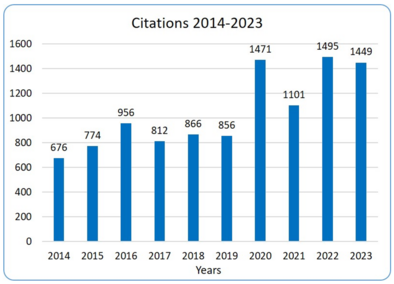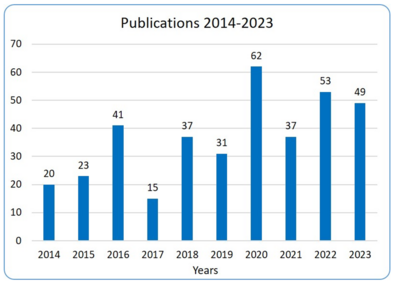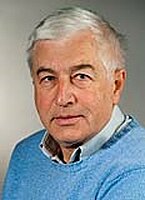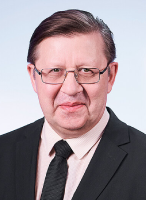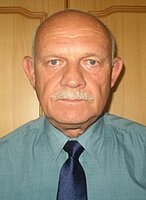ISSP UL LABORATORY OF KINETICS IN SELF-ORGANIZING SYSTEMS is well known internationally in the field of computational materials science.
The laboratory is a leader in the Baltic region in the large scale first principles modeling of the atomic and electronic structure of technologically important materials with a focus on nano-materials, defects, surfaces and interfaces.
Our activity is accompanied with the study of many-particle (cooperative) effects in the kinetics of bimolecular reactions in condensed matter, including radiation defects.
We model new dielectric and functional materials for the fusion reactiors exposed to an intensive radiation and high temperatures (e.g. in Tokamak-type reactors), and materials for modern energetics: nanomaterials for water splitting and hydrogen production, cathode materials for solid oxide fuel cells, proton conductors for fuel cells transforming chemical energy into electricity, materials for photovoltaics, etc.
The high quality of our research is also confirmed by the laboratory current participation in several international projects in the field of nano-materials and ecologically clean new energy sources.
| Scientific degree | Name Surname | Position | Contact information |
|---|---|---|---|
| Dr.habil.phys. | Vladimirs Kuzovkovs | Head of the laboratory and Leading researcher | Vladimirs.Kuzovkovs 27134915 |
| Dr.rer.nat. | Deniss Grjaznovs | Leading researcher | Deniss.Grjaznovs |
| Dr.habil.phys. | Jevgēnijs Kotomins | Leading researcher | Jevgenijs.Kotomins 67187480 |
| Dr.rer.nat. | Yuri Mastrikov | Leading researcher | Yuri.Mastrikov |
| Dr.phys. | Anatolijs Popovs | Leading researcher | Anatolijs.Popovs 67187480 |
| Dr.rer.nat. | Guntars Zvejnieks | Leading researcher | Guntars.Zvejnieks |
| Dr. Phys. | Leonīds Rusevičs | Leading researcher | Leonids.Rusevics 67187480 |
| Dr.sc.ing. | Marina Koņuhova | Researcher | Marina.Konuhova |
| Dr.phys. | Andrejs Česnokovs | Researcher | Andrejs.Cesnokovs |
| Ph.D. | Aleksandrs Platoņenko | Researcher | Aleksandrs.Platonenko 25956853 |
| Vladislavs Bezrukovs | Guest Researcher | Vladislavs.Bezrukovs | |
| Bc. | Aleksandra Moskina | Research Assistant | Aleksandra.Moskina |
| Mg. | Māra Putniņa | Research Assistant | Mara.Putnina |
| Iļja Červjakovs | Laboratory Assistant | Ilja.Cervjakovs | |
| Rostislavs Rostovskis | Laboratory Assistant | Rostislavs.Rostovskis | |
| Sofija Koņuhova | Laboratory Assistant | Sofija.Konuhova | |
| Elīna Koļesņikova | Laboratory Assistant | Elina.Kolesnikova |
1. Fluctuation-controlled kinetics
Many-particle systems may be characterized by a developed spectrum of reactant density fluctuations. It is found that the equations determining the structural characteristics consist of a infinite chain of coupled BBGKY-like equations. The accurate equation for the macroscopic concentration contains in the right hand side (via the reaction rate constants) the pair correlation functions. The pair correlation functions are determined via triple correlations etc. By this reason, the set of equations can be solved only using certain approximations.
The reduced description is introduced by applying only the simplest structural characteristics like the macroscopic concentrations and the pair correlation functions [1-3]. The comparison of two approaches (microscopic theory and computer simulation) shows that the description of the density fluctuation spectrum of the system does not lead to considerable mistakes in the determination of the correlation functions.


Figure. A system with a strong Coulomb interaction and short-range (Lennard-Jones) potential. Correlation functions plotted on the left panel demonstrate a series of peaks corresponding to the formation of the first, second, third etc coordination spheres typical for condensed matter. The right window shows the typical particle distribution restored using Reverse Monte Carlo method.
[1] E.A. Kotomin and V.N. Kuzovkov, "Modern aspects of diffusion-controlled reactions" (Amsterdam: Elsevier, 1996)].
[2] V.N. Kuzovkov and E.A. Kotomin, Kinetics of bimolecular reactions in condensed media: critical phenomena and microscopic self-organisation.- Rept. Progr. Phys., 1988, 51, p. 1479-1524.
[3] E.A. Kotomin and V.N. Kuzovkov, Phenomenological kinetics of Frenkel defect recombination and accumulation in ionic solids.- Rept. Progr. Phys., 1992, 55, p. 2079-2202.
2. Catalytic surface reactions
Nonlinear kinetics of reactions on surfaces demonstrate rich variety of phenomena such as pattern formation, global oscillations, and even chaotic behavior. Explaining kinetics of surface processes requires detection of a sequence of reactions that leads to the time-dependent reaction rates (e.g. an oscillation). For many systems such a sequence is known. For example, in the generally-accepted mechanism for CO oxidation on Pt(100) and Pt(110) the crucial factor is surface reconstruction. This can be lifted by adsorption of CO.
The existence of an oscillatory cycle in itself does not determine the kinetics. For most reaction conditions, and possibly even always, it occurs everywhere on the surface but out-of-phase. The result is either a normal equilibrium or steady state, or some form of pattern formation. To obtain a global oscillation, the phases of the local oscillations need to be synchronized.
In Figure the results of Monte Carlo (MC) simulations for CO oxidation on Pt(110) are presented [1-2]. The surface reconstructs and forms Turing-like structures with a definite width. The diffusion length needs only to exceed this width, to trigger global oscillations. If the diffusion is slower, one gets pattern formation in the adlayer. These patterns also have a characteristic length scale, which is however differ from that of the Turing-like structures which are present at the same time.

Figure. Sequence of snapshots of the model of CO oxidation on Pt(110). The bottom part shows the chemical species: CO particles are red, O particles are blue, and empty sites are black. The top part shows the structure of the surface: α phase sites are black, and β phase sites are white. From left to right, we show sections from the lower-left corner with sizes 4096 x 4096, 1024 x 1024, 256 x 256.
[1] O. Kortlüke, V.N. Kuzovkov, and W. von Niessen, Oscillation phenomena leading to chaos in a stochastic surface reaction model. - Phys. Rev. Letters, 1998, 81, p. 2164-2167.
[2] O. Kortlüke, V.N. Kuzovkov, and W. von Niessen, Global synchronisation via homogeneous nucleation in oscillating surface reaction.- Phys. Rev. Letters, 1999, 83, p. 3089-3092.
3. Optical and dielectric materials for fusion applications
Important part of the fusion reactors are functional optical and dielectric materials to be used as diagnostic windows, lenses, fibers, cables and in some other monitoring equipment. Thus it is of fundamental importance, to understand, control and predict their radiation damage under intensive neutron/gamma radiation environment.
In this investigation related to Eurofusion activities, we focus on several promising materials, first of all, diamond, Al2O3 (sapphire), MgO, MgF2, MgAl2O4, etc. Our activities combine first principles atomistic modeling of primary radiation defects and their basic properties, and the kinetics of radiation damage and metal colloid formation under powerful radiation. it is demonstrated that in strongly irradiated ionic solids of different crystalline structure and chemical nature, the pre-exponential factor of diffusion is strongly correlated with the migration energy.


Figure. Kinetics of the F or F+ center annealing in Al2O3 [1].
[1] E. Kotomin, V. Kuzovkov, A.I. Popov, J. Maier, and R. Vila.
Anomalous kinetics of diffusion-controlled defect annealing in irradiated ionic solids.
J. Phys. Chem. A, 2018, 122, pp. 28–32.
[2] A. Lushchik, E. Feldbach, E.A. Kotomin, I. Kudryavtseva, V.N . Kuzovkov, A.I . Popov, V. Seeman, E. Shablonin. Distinctive features of diffusion-controlled radiation defect recombination in stoichiometric magnesium aluminate spinel single crystals and transparent polycrystalline ceramics.
Sci. Rep., 2020, 10, 7810 (pp. 1-9).
4. Identification of radiation induced defects
Accumulation of radiation-induced intrinsic structural defects (arised from interstitial-vacancy Frenkel pairs) strongly affects the functionality of optical components. Therefore, the investigation of the mechanisms of stable radiation defect creation/accumulation and thermal annealing plays a crucial role. Long-lived (stable) defects are of crucial importance. We initiated a series of common studies together with Institute of Physics, University of Tartu within EUROfusion projects to study radiation-induced defects behavior at atomistic scale.
A single radiation induced superoxide ion in a-Al2O3 was identified using the EPR measurements (figure, left) for the first time. The O2- defect consists of regular and interstitial oxygens being stabilized by a trapped hole (dark red ions, figure, right). The obtained experimental results were in line with the superoxide defect configurations obtained via the hybrid DFT calculations. In addition, the calculations demonstrated asymmetric properties (reflected in magnetic moments in bold and atomic charges ) of the two oxygens in the most stable configuration.


[1] V. Seeman, A. Lushchik, E. Shablonin, G. Prieditis, D. Gryaznov, A. Platonenko, E.A. Kotomin, A.I. Popov. Atomic, electronic and magnetic structure of an oxygen interstitial in neutron‑irradiated Al2O3 single crystals. Sci. Rep., 2020, 10, 15852 (pp. 1-14).
5. Gyrotron development
Gyrotrons are devices which are well recognized as high-power sources of coherent electromagnetic radiation. In the millimeter- and submillimeter-wavelength regions, the power that gyrotrons can radiate in continuous-wave and long-pulse regimes exceeds the power of classical microwave tubes (klystrons, magnetrons, traveling-wave tubes, backward-wave oscillators, etc.) by many orders of magnitude.
Gyrotrons are based on the mechanism of coherent cyclotron radiation from electrons gyrating in a constant magnetic field. In these devices, the electrons can resonantly interact with fast waves, which in principle, can propagate even in free space. Therefore, the interaction space in gyrotrons can be much larger than in classical microwave tubes operating at the same wavelength. The arrangement of a simplest gyrotron is shown schematically in Figure.
Gyrotron oscillators can have a wide application, including technological processes, atmospheric sensing, ozone conservation, artificial ionospheric mirror, extra-high resolution electron spin resonance spectroscopy, nuclear magnetic resonance spectroscopy, new medical technology spectroscopy, etc. However, the main application of powerful gyrotrons is electron cyclotron resonance plasma heating in tokamaks and stellarators and the noninductive current drive in tokamaks. In the nearest future they will be used in the world’s largest tokamak ITER in France.

[1] O.Dumbrajs, and T. Idehara, Hysteresis in mode competition in high power 170 GHz gyrotron for ITER. International Journal of Infrared and Millimeter Waves, 2008, 29, p. 232-239
[2] O. Dumbrajs, Y. Kominis, and G. S. Nusinovich, Electron dynamics in the process of mode switching in gyrotrons. Phys. Plasmas, 2009, 16, 013102
[3] O. Dumbrajs and G. S. Nusinovich, To the theory of high-power gyrotrons with uptapered resonators. Phys. Plasmas, 2010, 17, 053104
6. Polarons in scintillating materials
The hybrid DFT calculations were performed for small radius polarons - self-trapped electrons (STEL) and holes (STH) in PbX2 (X= F, Cl, Br) crystals, widely used as parent materials for inorganic halide perovskites (CsPbX3) and scintillators. Both types of polarons were calculated for all three crystals. The atomic, electronic structure, spin and charge distributions and formation energies of STEL and STH were predicted for a-PbF2 (orthorhombic) and only STEL for b-PbF2 (cubic). Performed calculations solve controversies in the experimental literature and demonstrated that STH in PbCl2 is stable as Pb3+ monomer whereas a Cl2- dimer is unstable.
Despite lack of the direct experimental evidence of STEL or STH in a-PbF2 (orthorhombic), performed modelling clearly shows a possibility of their formation in a form of Pb35+ trimer (figure, left) and Pb3+ cation (figure, right), respectively.
It is shown how due to a delicate balance of ionic and covalent chemical bonding, hole localization changes from a single cation in fluorides and chlorides to anion dimer in bromides. In this case the calculations should stimulate new experimental studies on PbXn-based materials.


Figure. Orbital projected charge density of STEL (left) and STH (right) in a-PbF2. Dark grey balls denote Pb ions.
[1] Yu. A. Mastrikov, N. G. Chuklina, M. N. Sokolov, A. I. Popov, D. Gryaznov, E. A. Kotomin, J. Maier, Journal of Materials Chemistry C (submitted)
7. Computer design of mixed proton electron conductors for fuell cells
Fuel cells are ecologically friendly devices effectively transforming chemical energy into electricity.
Advantage of the Protonic Ceramic Fuell Cells (PCFC in figure, right) vs conventional Solid Oxide Fuel Cells (SOFC in figure, left) is due to lower operational temperature. The problem is to find optimal cathode materials with efficient transport of protons and holes at low temperatures.
Based on the first principles methods, we modelled several candidate materials: (Ba,Sr)FeO3−δ [1] and (La,Sr)FeO3−δ [2], with a focus on hydration properties. We analyzed the role of Fe oxidation state, electron holes and the number of oxygen vacancies. The calculated hydration energy spans a wide range from -0.2 eV in fully oxidized BaFeO3 to -1 eV in the reduced BaFeO2.5.and from 0.2 eV to -0.4 eV in Ba0.5Sr0.5FeO3−δ. Such values together with more positive hydration energy values for (La,Sr)FeO3−δ agree with the experimental trends. These results confirm experimental evidences that the hydration energy is less negative in the presene of holes. Moreover, its dependence on the hole concentration in non-linear in (Ba,Sr)FeO3−δ indicating that the holes affect the hydration reaction by being largely delocalized to the oxygen ions.

[1] M.F. Hoedl, D. Gryaznov, R. Merkle, E.A. Kotomin, J. Maier. Interdependence of oxygenation and hydration in mixed-conducting (Ba,Sr)FeO3−δ perovskites studied by density functional theory.
J. Phys. Chem. C, 2020, 124, pp. 11780−11789.
[2] D. Gryaznov, R. Merkle, E. A. Kotomin, J. Maier. Ab initio modelling of oxygen vacancies and protoinc defects in La(1-x)Sr(x)FeO3−δ. J. Mater. Chem. A, 2016, 4, pp. 13093−13104.
8. Water splitting modelling on faceted SrTiO3 surfaces
Strontium titanate (SrTiO3) is a perspective material for water splitting and hydrogen gas production. The processes of water adsorption and dissociation are studied on flat surfaces quite well. Recent developments in nanocrystal synthesis offered materials with enhanced charge separation due to the exposed anisotropic facets. Thus, 6- and 18-facet STO nanocrystals demonstrated high catalytic activity in water splitting. Doped on particular facets, by Pt and Co3O4, these nanoparticles exhibited even higher performance. Such an improvement is attributed to the unique properties of anisotropic facets of the particles. Presently, the structure of the surface of these nanoparticles is described only at the macro scale. To reveal the properties of different reaction areas of multi-faceted nanoparticles, we designed and tested an atomistic model, and performed large scale computer modelling of water adsorption and dissociation on different sites at faceted surfaces (Fig.1). The adsorption energies, charge redistribution between molecule and surfaces were calculated based on the first principles methods (hybrid functionals). These calculations open the way to design nanoparticles with optimal shape and size, considerably increasing splitting efficiency.

[1] M. Tyunina, L.L. Rusevich, E.A. Kotomin, O. Pacherova, T. Kocourek, A. Dejneka.
Epitaxial growth of perovskite oxide films facilitated by oxygen vacancies. J. Mater. Chem. C, 2021, 9, pp. 1693-1700.
[2]. A. Senocrate, E. Kotomin, J. Maier. On the way to optoionics. Helv. Chim. Acta, 2020, 103, e2000073 (pp. 1-8).
9. Heterostructures for watersplittin
Ferroelectric layered perovskites Bi4Ti3O12 are promising technological materials due to their physical properties e.g. as efficient catalysts for photochemical reactions and substrates for SrTiO3 (STO) -- BiTO/STO heterostructures-- for water splitting. Therefore, development of physical models that explain the driving mechanisms behind this behavior could further facilitate the development of next generation materials. It is expected that such interfaces could enhance charge separation and thus increase water splitting. The first problem is identification of the BiTO crystalline structure and its symmetry.
We used first principles linear combination of atomic orbitals (LCAO) approach combined with hybrid density functional theory (DFT) formalism, to model BTO in different orthorhombic symmetries, including Fmmm and B2cb. We find that BTO initial geometry within orthorhombic Fmmm symmetry reduces to a tetragonal I4/mmm one, where both in-plane lattice constants coincide. This result qualitatively disagrees with a number or experimental studies that reported Fmmm phase of BTO. First principle calculations demonstrate that in order to obtain orthorhombic BTO lattice geometry with different in-plane lattice constants the symmetry should be further reduced, e.g., to B2cb space group.
Our theoretical predictions were supported using high quality BiTO nanocrystals and elaborated experimental techniques (in collaboration with M.Kržmanc and A. Meden, Slovenia).

Figure. Schematic view of the BiTO structure: red O, blue Ti, purple Bi atoms
[1]. G. Zvejnieks, L.L. Rusevich, D. Gryaznov, E.A. Kotomin. Interface-induced enhancement of piezoelectricity in the (SrTiO3)m/(BaTiO3)M-m superlattice for energy harvesting applications.
Phys. Chem. Chem. Phys., 2019, 21, pp. 23541-23551.
Lead by Prof. Dr. habil. Eugene Kotomin, the HPRG specializes in Computational Chemistry and Computational Material Science, deploying High Performance Computing. Since 2002 the ISSP has its own supercomputer Latvian Super Cluster, which is constantly kept upgraded. The HPRG members also have access to several external computational resources in the EU and the US.
Members of the Group:
Prof. E. Kotomin – the group leader,
Dr. D. Bocharov, M.Sc. A. Chesnokov, Dr. D. Gryaznov, Dr. R. Eglitis, Dr. A. Gopejenko, MSc. A. Ivanova, MSc. O. Lisovski, Dr. Yu. Mastrikov, Dr. S. Piskunov, M.Sc. A. Platonenko, Dr. L. Rusevich, MSc. M. Sokolov, Dr. A. Sorokin, MSc D. Zavickis and Dr. G. Zvejnieks
The HPRG performs Computational Experiments for advanced materials and defects therein by means of the state-of-the-art computer codes.
Access to the following codes is restricted, according to the License Agreements:
CRYSTAL code / Licence agreement
The contact person: Dr. S. Piskunov; sergejs.piskunovs@cfi.lu.lv
The code is licensed for use in ISSP UL.
Vienna ab Initio Simulation Package (VASP)
The contact person Dr Yuri Mastrikov, yuri.mastrikov@cfi.lu.lv
The list of Licensed Users: Juri Mastrikov, Dmitry Bocharov, Denis Gryaznov, Eugene Kotomin
Other computer codes, used by the group members:
ABINIT, NWCHEM, CP2K, Quantum ESPRESSO
Active projects:
COST
Multiscale Irradiation and Chemistry Driven Processes and Related Technologies (CA20129) (2021-2025)
EraNet
Horizon 2020 - EUROfusion
Functional materials (WPMAT-FM) (2021-2025)
Latvian Council of Science
Dynamic self-assembly of materials under harsh radiation conditions (2025-2027)
Development of new advanced phosphors for lighting and non-contact optical thermometry (2024-2026)
Accomplished projects:
COST
Towards Understanding and Modeling Intense Electronic Excitation (2018-2022)
Reducible oxide chemistry, structure and functions (2012-2016)
EC Frameworks Projects
EraNet
European Social Fund
Innovative materials for transparent electronics and photonics (2013-2015)
Horizon 2020 - EUROfusion
Multiscale modelling of radiation effects in MgAl2O4 spinel and general oxides (2014-2020)
Latvian Council of Science
Theoretical prediction of new materials for intermediate temperature ceramic fuel cells (2018-2021)
Computational study of new advanced perovskites for energy applications (2020-2021)
Dynamic Self-Assembling at nano scale (2013-2016)
Latvian-Ukrainian Bilateral Cooperation Program
Latvian-Ukrainian Bilateral Cooperation Program in the Area of Science and Technology
National Research Program
For the past 40 years, the effectiveness of scientific work was evaluated using the following parameters:
- Number of publications;
- Citation frequency of works;
- The impact factor of the scientific journal in which they were published;
- Number of national and international grants received;
- Participation of researchers in international research projects and in the editorial boards of scientific journals
The most cited papers
E. Heifets, R.I. Eglitis, E.A. Kotomin, J. Maier, and G. Borstel.
Ab initio modeling of surface structure for SrTiO3 perovskite.
Physical Review B, Volume: 64, Issue: 23, Published: DEC 15 2001
DOI: 10.1103/PhysRevB.64.235417
Cited by 277 (2024)
E.A. Kotomin, and A.I Popov.
Radiation-induced point defects in simple oxides.
Nuclear Instruments & Methods in Physics Research Section B-Beam Interactions With Materials and Atoms, Volume: 141, Issue: 1-4, Pages: 1-15, Published: MAY 1998
DOI: 10.1016/S0168-583X(98)00079-2
Cited by 271 (2024)
V.N. Kuzovkov, and E.A. Kotomin.
Kinetics of bimolecular reactions in condensed media - critical phenomena and microscopic self-organisation.
Reports on Progress in Physics, Volume: 51, Issue: 12, Pages: 1479-1523, Published: DEC 1988
DOI: 10.1088/0034-4885/51/12/001
Cited by 256 (2024)
V.N. Kuzovkov, and E.A. Kotomin.
Kinetics of bimolecular reactions in condensed media - critical phenomena and microscopic self-organisation.
Reports on Progress in Physics, Volume: 51, Issue: 12, Pages: 1479-1523, Published: DEC 1988
DOI: 10.1088/0034-4885/51/12/001
Cited by 244 (2020)
E. Heifets, R.I. Eglitis, E.A. Kotomin, J. Maier, and G. Borstel.
Ab initio modeling of surface structure for SrTiO3 perovskite.
Physical Review B, Volume: 64, Issue: 23, Published: DEC 15 2001
DOI: 10.1103/PhysRevB.64.235417
Cited by 228 (2020)
E.A. Kotomin, and A.I Popov.
Radiation-induced point defects in simple oxides.
Nuclear Instruments & Methods in Physics Research Section B-Beam Interactions With Materials and Atoms, Volume: 141, Issue: 1-4, Pages: 1-15, Published: MAY 1998
DOI: 10.1016/S0168-583X(98)00079-2
Cited by 224 (2020)
Impact factor of journals
Y. A. Mastrikov, M. M. Kuklja, E. A. Kotomin and J. Maier, "First-principles modelling of complex perovskite (Ba1-xSrx)(Co1-yFey)O3-δ for solid oxide fuel cell and gas separation membrane applications, Energy & Environmental Science, vol. 3, no. 10, p. 1544, 2010. [IF=30.289]
E.A. Kotomin and V.N. Kuzovkov, Phenomenological Theory of the Recombination and Accumulation Kinetics of Radiation Defects in Ionic Solids. - Rept. Progr. Phys., 1992, 55, p. 2079-2202. [IF=16.620]
V.N. Kuzovkov and E.A. Kotomin, Kinetics of Bimolecular Reactions in Condensed Media: critical phenomena and microscopic self-organisation. - Rept. Progr. Phys., 1988, 51, p. 1479-1524. [IF=16.620]
Significant Personal Achievements
The most significant (top ten) achievement of Latvian Science (awarded by the Latvian Academy of Sciences)
R. Eglitis, J. Purans, A.I. Popov, R. Jia, “Powering tomorrow: Unlocking the potential of graphene, batteries, superconductivity and photocatalysis”, 2024
E.A. Kotomin, Yu.A. Mastrikov, L.L. Rusevich, M. Sokolov, G. Zvejnieks, “Computer simulations of perovskite nanoparticles for effective hydrogen production”, 2023.
The most significant (top ten) achievement of Latvian Science (awarded by the Latvian Academy of Sciences): A.I. Popov, V.N. Kuzovkov, E.A. Kotomin, D. Gryaznov, A. Platonenko, E. Shablonin, A. Lushchik, "Deep understanding and prediction of advanced materials for extreme radiation conditions", 2020.
V.N. Kuzovkov was awarded E. Silinsh prize in physics of Latvian Academy of Sciences for the series of publications „From chaos to ordering via diffusion”, 2014.
E.A. Kotomin was awarded Fr. Zander prize in physics and mathematics of Latvian Academy of Sciences for a research in “Solid state defect theory” (including 3 monographies), 1997.
Eugene Kotomin Documents by author 480 |
Anatoli Popov Documents by author 350 |
Olgierd Dumbrajs Documents by author 266 |
Selected books and book chapters
K. Sickafus and E.A. Kotomin (eds.) Radiation Effects in Solids. NATO ASI Science series II, Physics, Chemistry, Mathematics, 2006, vol. 235, Amsterdam, Berlin, Oxford, 560 p.
C.R.A. Catlow and E.A. Kotomin (eds.) Computational Materials Science. NATO Science series III. Computer and System Sciences, 2003, vol. 187, Amsterdam, Berlin, Oxford.
E.A. Kotomin and V.N. Kuzovkov, Modern Aspects of Diffusion-Controlled Processes: Cooperative Phenomena in Bimolecular Reactions. Amsterdam: Elsevier (Vol. 34in Comprehensive Chemical Kinetics), 1996, 612 p.
E.A. Kotomin, R. Merkle, Yu.A. Mastrikov, M.M. Kuklja, and J. Maier, Energy Conversion: Solid Oxide Fuel Cells. First-Principles Modeling of Elementary Processes. - Chapter 6 in book: Computational Approaches to Energy Materials (eds. A.Walsch, A.Sokol, C.R.A. Catlow, Wiley), 2013, p. 149-186.
V.N. Kuzovkov, E.A. Kotomin, G. Zvejnieks, K.D. Li, T.H. Ding, and L.M. Wang, Void Superlattice Formation in Electron Irradiated Materials. -Chapter 11 in e-book Series: "Advances in Materials Science Research" (Ed. Maryann C. Wythers, Nova Science Publishers), 2011, Vol. 2, p. 191-216.
Main review articles
M.M. Kuklja, E.A. Kotomin, R. Merkle, Yu.A. Mastrikov, and J. Maier, Combined theoretical and experimental analysis of processes determining cathode performance in solid oxide fuel cells. - Phys. Chem. Chem. Phys. (Perspective), 2013, 15, p. 5443-5471.
Yu.F. Zhukovskii, E.A. Kotomin, R.A. Evarestov, and D.E. Ellis, Periodic models in quantum chemical simulations of F centers in crystalline metal oxides. - Intern. J. Quant. Chem., 2007, 107, p. 2956-2985.
E.A. Kotomin and A.I. Popov, The kinetics of radiation-induced point defect aggregation and metallic colloid formation in ionic solids. In: Radiation Effects in Solids (NATO ASI Science Series II. Physics, Chemistry and Mathematics, Vol. 235), Amsterdam, Berlin, Oxford, 2006, p. 153-192.
E.A. Kotomin and V.N. Kuzovkov, Phenomenological Theory of the Recombination and Accumulation Kinetics of Radiation Defects in Ionic Solids. - Rept. Progr. Phys., 1992, 55, p. 2079-2202.
V.N. Kuzovkov and E.A. Kotomin, Kinetics of Bimolecular Reactions in Condensed Media: critical phenomena and microscopic self-organisation. Rept. Progr. Phys., 1988, 51, p. 1479-1524.
USA:
- University of Maryland, USA (Dept of Materials Science and Engineering; Institute for Research in Electronics and Applied Physics)
Israel:
- Ben-Gurion University of the Negev, Beer-Sheva (Department of Materials Engineering)
- Weizmann Institute of Science (Dept of Materials and Interfaces), Rehovot
Italy:
- University of Turin (Theoretical Chemistry group)
Lithuania:
- Vilnius University
Norway:
- University of Oslo, Department of Chemistry
Romania:
- National Institute of Materials Physics, Iasy
Germany:
- Max Planck Institut für Festkörperforschung, Stuttgart, Germany (Abt. Physikalische Festkörperchemie)
- Max Planck Institut für Plasmaphysik, Garching (Association Euratom-IPP)
- Karlsruhe Institute of Technology (KIT)
Estonia:
- Institute of Physics, University of Tartu
Spain
- CIEMAT, Madrid
Slovenia
- Jozef Stefan Institute, Ljubljana
Ukraine
- Lviv University
2024
E.A. Kotomin, V.N. Kuzovkov, A. Lushchik, A.I. Popov, E. Shablonin, T. Scherer, E. Vasil’chenko. The annealing kinetics of defects in CVD diamond irradiated by Xe ions. Crystals 2024, 14, 546 (pp. 1-14).
L.L. Rusevich, E.A. Kotomin, A.I. Popov, G. Aiello, T.A. Scherer, A. Lushchik. The electronic, vibrational and dielectric properties of diamond crystals with neutral vacancies: first principles study. Opt. Mater. 2024, 150, 115222 (pp. 1-9).
2023
M. Tyunina, L.L. Rusevich, M. Savinov, E.A. Kotomin, A. Dejneka. Dielectric behaviour of nitrogen doped perovskite SrTiO3-δNδ films. J. Mater. Chem. C, 2023, 11, pp. 16689–16698.
G. Zvejnieks, Yu. Mastrikov, D. Gryaznov. Jahn–Teller distortion in Sr2FeO4: group‑theoretical analysis and hybrid DFT calculations. Sci. Rep., 2023, 13, 16446 (pp. 1-14).
2022
L.L. Rusevich, E.A. Kotomin, G. Zvejnieks, M. Maček Kržmanc, S. Gupta, N. Daneu, J.C.S. Wu, Y.-G. Lee, W.-Y. Yu. Effects of Al doping on hydrogen production efficiency upon photostimulated water splitting on SrTiO3 nanoparticles. J. Phys. Chem. C, 2022, 126, pp. 21223−21233.
A. Kozlovskiy, D.I. Shlimas, M.V. Zdorovets, A. Moskina, V. Pankratov, A.I. Popov. Study of the effect of two phases in Li4SiO4—Li2SiO3 ceramics on the strength and thermophysical parameters. Nanomaterials, 2022, 12, 3682 (pp. 1-12).
Y.-R. Wang, G.Y. Kim, E. Kotomin, D. Moia, J. Maier. Photo de-mixing in mixed halide perovskites: the roles of ions and electrons. J. Phys. Energy, 2022, 4, 011001 (pp. 1-11).
2021
A. Chesnokov, D. Gryaznov, N.V. Skorodumova, E.A. Kotomin, A. Zitolo, M. Zubkins, A. Kuzmin, A. Anspoks, J. Purans. The local atomic structure and thermoelectric properties of Ir-doped ZnO: hybrid DFT calculations and XAS experiments. J. Mater. Chem. C, 2021, 9, pp. 4948–4960.
G. Zvejnieks, D. Zavickis, E.A. Kotomin, D. Gryaznov. BaCoO3 monoclinic structure and chemical bonding analysis: hybrid DFT calculations. Phys. Chem. Chem. Phys., 2021, 23, pp. 17493–17501.
M. Tyunina, L.L. Rusevich, E.A. Kotomin, O. Pacherova, T. Kocourek, A. Dejneka. Epitaxial growth of perovskite oxide films facilitated by oxygen vacancies. J. Mater. Chem. C, 2021, 9, pp. 1693-1700.
2020
V. Seeman, A. Lushchik, E. Shablonin, G. Prieditis, D. Gryaznov, A. Platonenko, E.A. Kotomin, A.I. Popov. Atomic, electronic and magnetic structure of an oxygen interstitial in neutron‑irradiated Al2O3 single crystals. Sci. Rep., 2020, 10, 15852 (pp. 1-14).
A. Lushchik, E. Feldbach, E.A. Kotomin, I. Kudryavtseva, V.N . Kuzovkov, A.I . Popov, V. Seeman, E. Shablonin. Distinctive features of diffusion-controlled radiation defect recombination in stoichiometric magnesium aluminate spinel single crystals and transparent polycrystalline ceramics. Sci. Rep., 2020, 10, 7810 (pp. 1-9).
G. Di Palma, B. Kirtman, F.S. Gentile, A. Platonenko, A.M. Ferrari, R. Dovesi. The VN2 negatively charged defect in diamond. A quantum mechanical investigation of the EPR response. Carbon, 2020, 159, pp. 443-450.
E.A. Kotomin, Yu.A. Mastrikov, R. Merkle, J. Maier. First principles calculations of oxygen reduction reaction at fuel cell cathodes. Curr. Opin. Electrochem., 2020, 19, pp. 122–128.
2019
L.L. Rusevich, G. Zvejnieks, E.A. Kotomin, M. Maček Kržmanc, A. Meden, Š. Kunej, I.D. Vlaicu. Theoretical and experimental study of (Ba,Sr)TiO3 perovskite solid solutions and BaTiO3/SrTiO3 heterostructures. J. Phys. Chem. C, 2019, 123, pp. 2031−2036.
D. Zablotsky, L.L. Rusevich, G. Zvejnieks, V. Kuzovkov, E. Kotomin. Manifestation of dipole-induced disorder in self-assembly of ferroelectric and ferromagnetic nanocubes. Nanoscale, 2019, 11, pp. 7293-7303.
2018
Yu.A. Mastrikov, R. Merkle, E.A. Kotomin, M.M. Kuklja, and J. Maier. Surface termination effects on the oxygen reduction reaction rate at fuel cell cathodes. J. Mater. Chem. A, 2018, 6, pp. 11929–11940.
E. Kotomin, V. Kuzovkov, A.I. Popov, J. Maier, and R. Vila. Anomalous kinetics of diffusion-controlled defect annealing in irradiated ionic solids. J. Phys. Chem. A, 2018, 122, pp. 28–32.
2017
R.A. Evarestov, D. Gryaznov, M. Arrigoni, E.A. Kotomin, A. Chesnokov and J. Maier, Use of site symmetry in supercell models of defective crystals: polarons in CeO2. - Phys. Chem. Chem. Phys., 2017, 19, p. 8340-8348.
E. Heifets, E.A. Kotomin, A.A. Bagaturyants and J. Maier, Thermodynamic stability of stoichiometric LaFeO3 and BiFeO3: a hybrid DFT study. - Phys. Chem. Chem. Phys., 2017, 19, p. 3738-3755.
2016
O. Dumbrajs, T. Saito, and Y. Tatematsu, Start-up scenario of a high-power pulsed gyrotron for 300 GHz band collective Thomson scattering diagnostics in the Large Helical Device. - Phys. Plasmas, 2016, 23, 023106 (p. 1-8).
T.S. Bjørheim, M. Arrigoni, S.W. Saeed, E.A. Kotomin, and J. Maier, Surface segregation entropy of protons and oxygen vacancies in BaZrO3. - Chem. Mater., 2016, 28, p.1363−1368.
2015
E. Heifets, E.A. Kotomin, A.A. Bagaturyants, and J. Maier, Ab initio study of BiFeO3: Thermodynamic stability conditions. - J. Phys. Chem. Lett., 2015, 6, p. 2847−2851.
T.S. Bjørheim, E.A. Kotomin, and J. Maier, Hydration entropy of BaZrO3 from first principles phonon calculations. - J. Mater. Chem. A, 2015, 3, p. 7639–7648.
2014
T.S. Bjørheim and E.A. Kotomin, Ab initio thermodynamics of oxygen vacancies and Zinc interstitials in ZnO. - J. Phys. Chem. Lett., 2014, 5, p. 4238−4242
D. Gryaznov, S. Baumann, E.A. Kotomin, and R. Merkle, Comparison of permeation measurements and hybrid density-functional calculations on oxygen vacancy transport in complex perovskite oxides. - J. Phys. Chem. C, 2014, 118, p. 29542−29553.
V.N. Kuzovkov, G. Zvejnieks, and E.A. Kotomin, Theory of non-equilibrium critical phenomena in three-dimensional condensed systems of charged mobile nanoparticles. - Phys. Chem. Chem. Phys., 2014, 16, p. 13974-13983.
